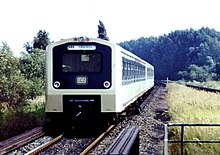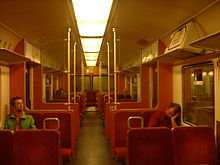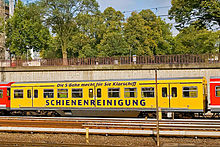DB class 472
| DB class 472/473 | |
|---|---|
|
DB class 472/473
|
|
| Number: | 1st series (472.1) 30 units (still 17 units in operation) 2nd series (472.2) 32 units (still 17 units in operation) |
| Manufacturer: | LHB , MBB , WMD , SSD |
| Year of construction (s): | 1974–1976 (1st series), 1982–1984 (2nd series) |
| Retirement: | since 2018 |
| Axis formula : | Bo'Bo '+ Bo'Bo' + Bo'Bo ' |
| Gauge : | 1435 mm ( standard gauge ) |
| Length over coupling: | 65,820 mm |
| Height: | 3,800 mm |
| Width: | 3,020 mm |
| Trunnion Distance: | 16,190 mm |
| Bogie axle base: | 2,500 mm |
| Empty mass: | 114.4 t |
| Top speed: | 100 km / h |
| Hourly output : | 12 × 125 kW = 1500 kW |
| Acceleration: | 1.15 m / s² |
| Driving wheel diameter: | 850/780 mm |
| Motor type: | DC series connection 1KB 2122-0TA02 |
| Power system : | 1200 V DC |
| Power transmission: | Lateral busbar coated from the side |
| Coupling type: | Scharfenberg coupling |
| Seats: | 196 |
| Standing room: | 304 |
| Floor height: | 1,120 mm |
The need for the series 472/473 electric multiple units arose with the further expansion of the Hamburg S-Bahn network in the early 1970s. This series was completely redesigned, but the floor plan was derived from the 470 series . The three-part multiple units have an all-axle drive with DC motors.
The Deutsche Bundesbahn ordered a total of 62 units from the general contractor MAN , which were delivered to Hamburg from 1974 to 1984. The companies LHB , MBB , WMD and Siemens , the Federal Railway Central Office in Munich and the Federal Railway Directorate in Hamburg contributed to the development of the 472 series. All vehicles are based in the Hamburg-Ohlsdorf depot.
Reasons for developing a new series
The first acquisition of this series of 30 trains was necessary for the Deutsche Bundesbahn because the Hamburg City-S-Bahn network was being expanded. Instead of procuring more vehicles of the 470 series , the Federal Railroad decided on a more expensive new development because gradients of up to 40 per mille had to be mastered on the routes of the new City S-Bahn . For this purpose, the new series 472 was developed, in which, in contrast to the previous vehicles, the intermediate cars were also powered; this should ensure reliable driving on the slopes.
Construction of the car
A welded lightweight construction was chosen for the car bodies. Glass fiber reinforced polyester was chosen as the building material for the front face. In contrast to the previous series 470/471, there is only one window in the front, behind which the driver's desk is located in the middle. The driver's cab can also be accessed from the outside via inward-turning doors. Access to the passenger compartment is made possible by four double-leaf, electro-pneumatically operated pivoting sliding doors on each side of the end car; in the middle car there are three such sliding doors on each side. There are no transitions between the cars. The upper third of the windows can be folded inwards in two stages, with the second series having significantly fewer hinged windows.
The cars were delivered in an ocean blue / beige paint. However, the division of colors, i.e. dark above and light below, was not based on the rule scheme at the time - which was also introduced in 1974 - but on the so-called pop paint from 1969. Until the renovation that began in 1996, some trains were also fully advertised pasted or painted. A special feature of the series was the original line and destination signage using a fall-leaf display , which, however, was first replaced by a roller tape display and later by a digital display in the course of the redesign.
Couplings
The three carriages of a unit are connected to each other with close couplers. With this coupling, the cars can only be disconnected in the workshop.
The multiple units have automatic Scharfenberg couplings on the front ends . In order to be able to use the trains of the 470 and 471 series in traction operation (as full or long trains), the couplings were designed so that there is mechanical and electrical coupling capability. It is important to note that the electrical contacts are divided into three parts: the middle (wide) part is required for the coupling with the previous series, the two narrow outer parts are only functional for the coupling with trains of the same series. The multiple units of the newer class 474 and the VT 2E have a purely mechanical coupling option with a functional compressed air brake (e.g. for towing operations), but regular mixed operation is not possible. Coupling with the 490 series is neither mechanically nor electrically possible.
technology
The car body is cushioned by rubber and air suspension on the bogie.
There is a four-pole direct current motor in series on each of the twelve wheel sets . The drive is designed as a pawl bearing drive .
The cam circuit and other electrical devices, including a thyristor pulse control , were housed in the floor pan of the car.
The multiple units can run in combination with a total of up to three units of this series or with the older trains of the 471 and 470 series.
Passenger compartment
Passengers in the intermediate car, the class 473, have 66 seats and in the two cars of the class 472, according to the “redesign”, 61 seats are available. As with the previous 470 series, the cars have four-seater seating groups and a load compartment behind each driver's cab. The latter is also equipped with a stowable wheelchair ramp.
Division and procurement
Each three-part multiple unit has two class 472 end cars and a class 473 intermediate car, all three cars are powered.
Each car is used in a permanent train set. The numbers of the three-part short train are between 201 and 262, whereby the last two digits of the car number always also represent the last two digits of the short train number, supplemented by a preceding 2 . Each car in turn has its own number; the A-cars 2001 to 2062, the intermediate cars 3001 to 3062 and the B-cars 2501 to 2562.
In contrast to the outside car (BR 472), the middle car (BR 473) is only equipped with three doors on each side of the car due to its original use as a 1st class wagon and the resulting lower number of passengers, but has a shorter length of only 19 .04 meters over seating for 66 passengers. With the abandonment of 1st class at S-Bahn Hamburg GmbH in November 2000, the ET 473 was also released without restriction.
Each railcar of this series has two pantographs on each side of the wagon, which coat the side of the conductor rail attached to the main track. Due to the missing pantograph, it is not possible to use the S3 further than new trenches or other routes than those of the Hamburg direct current network.
In the years 1974–1976 and 1982–1984 a total of 62 multiple units were procured in two series. The first series was used to expand the vehicle fleet for the upcoming opening of the City S-Bahn , the second series was procured in view of the new Harburg S-Bahn . Both series only differ in details: the second series has fewer hinged windows and a different door construction; In addition, the first series has two closed roof scoops on the driver's cabs, in which technology cabinets were later to be housed - since this was waived, the second series does not have them.
Processing / "re-design"
In the first 20 years, the vehicles were only used with minor changes. In 1997 a redesign program was started to modernize the vehicles for further years of use and to adapt them optically to the successor series 474. The vehicles were given a new paint in traffic red and a completely renovated interior in the design of the 474 series - the first series also received viewing windows between the cars, the second series already had them ex works. An emergency call system was also installed. The first series was given different interior colors: the end cars of the 2nd class have since been presented with mint green partitions, the intermediate cars of the 1st class with purple partitions. The second series, on the other hand, was only used for redesign when 1st class was abolished - here all cars were equipped with purple partition walls. During the redesign, the luggage racks were removed without replacement after vandalism damage.
The majority of the vehicles, one exception being the 250 multiple unit, for example, lost their drop-leaf displays with the redesign, and conventional scrolling displays were installed. However, these were removed again at the end of the 2000s and replaced by more flexible LCD displays . At the same time, with this step, the series received digital stop displays in the passenger compartment.
The completion of the redesign in 2005 overlapped with the retirement of some units that had become redundant, so that two multiple units (251 and 252) were no longer modernized and were scrapped in their original condition in 2006. All other multiple units went through the redesign between 1997 and 2005.
Duration of use and future replacement
Ten multiple units from both series were taken out of service between 2004 and 2006, as their use was no longer considered necessary due to a previously lower volume of traffic on the S-Bahn. Previously there were only decommissioning of individual wagons due to accident and fire damage; the lost wagons were always replaced.
In January 2012, the operation of the Hamburg S-Bahn network from December 2018 to December 2033 was tendered in a public tender. As part of this procedure, it was stipulated that, from 2018, the network may only be operated with DB class 474 and new vehicles. This was originally intended to end the regular use of the 472 series at the end of 2019. Originally, a total of 72 DB class 490 trains were to be delivered as new vehicles (as of 2019) from 2016 . They should all be delivered by December 2018 and replace the remaining 52 units of the BR 472. Due to delivery delays and the high susceptibility of the new 490 series to damage, the 472 series is still in use with 32 units (as of August 2020); at the end of 2018, another five units were subjected to an unscheduled main inspection.
The first multiple units (since 2006) were retired in summer 2018 and scrapped soon afterwards, and more and more units have followed since then. After the vehicles have barely been used on their former main lines S2 and S21 since the end of 2018 / beginning of 2019, the S31 was "converted back" to the 472 series in March 2019 in order to release trains of the 474 series, which on the one hand are intended to reinforce the heavily loaded S3 and at the same time to replace damaged ET 490 on the S21 at short notice. In November 2019, the conversion of the S31 to the new 490 series also began, so that the 472 series continues to decline.
Rail cleaning train
The multiple unit with the number 472 029 was converted into a rail cleaning train every autumn before it was retired in 2019, with which the lubricating films on the rails can be removed. These greasy films, which are caused by leaves and moisture, especially in autumn, are removed with powerful water jets. The intermediate car 473 010 (unit 210 was retired at the end of 2006) was equipped with a cleaning system for this purpose. Two high-pressure units generate the necessary water pressure of 500 bar . The car carries 11,600 liters of water. This tank capacity is sufficient to clean around 150 kilometers of rails. The cleaning takes place at a speed of about 40 km / h. The system is operated by the driver while driving. Since the original "carrier train" 229 was retired and scrapped in May 2019, unit 214 will be used as a rail cleaning train in autumn 2019.
literature
- Martin Pabst: U- and S-Bahn vehicles in Germany . 1st edition. GeraMond, Munich 2000, ISBN 3-932785-18-5 .
Web links
Individual evidence
- ↑ Public invitation to tender: Transport performance of the Hamburg S-Bahn from December 2018
- ↑ The tender for the Hamburg S-Bahn started on January 5, 2012
- ↑ Delivery from 2016: This is what Hamburg's new S-Bahn trains look like. June 28, 2013, accessed April 2, 2017 .
- ↑ Deutsche Bahn AG (ed.): New rail cleaning train of the Hamburg S-Bahn in use with immediate effect. Hamburg October 28, 2008. Retrieved October 29, 2008.



